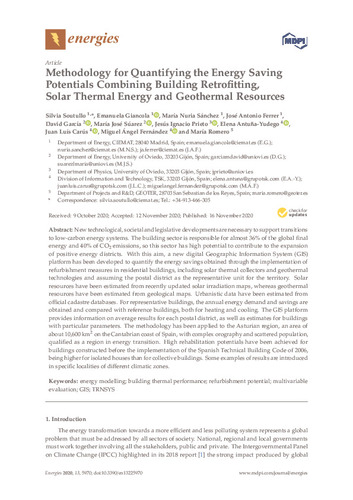Methodology for Quantifying the Energy Saving Potentials Combining Building Retrofitting, Solar Thermal Energy and Geothermal Resources
Subject:
energy modellinge
building thermal performance
Publication date:
Publisher version:
Citación:
Descripción física:
Abstract:
Newtechnological, societal and legislative developments are necessary to support transitions to low-carbon energy systems. The building sector is responsible for almost 36% of the global final energy and 40% of CO2 emissions, so this sector has high potential to contribute to the expansion of positive energy districts. With this aim, a new digital Geographic Information System (GIS) platform has been developed to quantify the energy savings obtained through the implementation of refurbishment measures in residential buildings, including solar thermal collectors and geothermal technologies and assuming the postal district as the representative unit for the territory. Solar resources have been estimated from recently updated solar irradiation maps, whereas geothermal resources have been estimated from geological maps. Urbanistic data have been estimated from o cial cadastre databases.
Newtechnological, societal and legislative developments are necessary to support transitions to low-carbon energy systems. The building sector is responsible for almost 36% of the global final energy and 40% of CO2 emissions, so this sector has high potential to contribute to the expansion of positive energy districts. With this aim, a new digital Geographic Information System (GIS) platform has been developed to quantify the energy savings obtained through the implementation of refurbishment measures in residential buildings, including solar thermal collectors and geothermal technologies and assuming the postal district as the representative unit for the territory. Solar resources have been estimated from recently updated solar irradiation maps, whereas geothermal resources have been estimated from geological maps. Urbanistic data have been estimated from o cial cadastre databases.
ISSN:
DOI:
Patrocinado por:
The authors would like to acknowledge the support given by the rest of the members and institutions participating in the REHABILITAGEOSOL (RTC-2016-5004-3) project. The computationalwork has been carried out using the computer facilities of the Extremadura Center for Advanced Technologies (CETA-CIEMAT).
Collections
- Artículos [36307]
- Energía [250]
- Investigaciones y Documentos OpenAIRE [7936]
Files in this item





